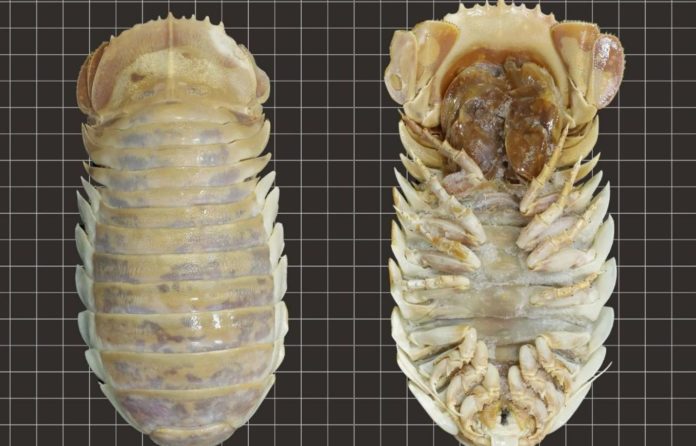Researchers have found a new species of Bathonymus, a famous group of deep-sea isopods that have become the most well-known aquatic crustaceans since Sebastian from “The Little Mermaid.”
Bathonymus is a mysterious and primitive group that lives in the ocean’s deepest regions, which are rarely investigated by humans. There are around 20 species of Bathonymus. The crabs, shrimp, and lobsters, which are the more well-known decapod relatives of isopod crustaceans, are only distantly related to them.
Researchers from Taiwan, Japan, and Australia have discovered the newest addition to this list: B. yucatanensis, a new species that is around 26 cm long and is roughly 2,500 percent larger than the typical woodlouse. They have published their findings in the peer-reviewed Journal of Natural History.
The terrestrial isopods known as woodlice, pillbugs, and roly polys, which feed on decomposing debris and are probably familiar to anybody who has picked up a rock or dug in the yard, are members of the same group as deep water isopods. Except for their remarkable size—the largest of them grows to about 50 centimeters—they do really resemble one another fairly closely. Like woodlouse, they may appear a little frightening, but they are entirely safe for people to encounter.
Their weird shapes and sizes have inspired a lot of memes and products, from plush toys to phone cases, that celebrate how cutely weird they are.
With the discovery of B. yucatanensis, there are now three recognized species of Bathonymus in the Gulf of Mexico, up from two previously—B. giganteus was identified in 1879 and B. maxeyorum in 2016.
It was first believed to be an alteration of one of the biggest deep-sea isopods, B. giganteus. But a closer look at the specimen, which was discovered in 2017 in the Gulf of Mexico off the Yucatán Peninsula at a depth of between 600 to 800 meters, revealed a variety of unusual characteristics.
The authors assert that B. yucatanensis is morphologically distinct from B. giganteus and B. maxeyorum.
The specimen under study, which was kept at the Japanese aquarium Enoshima, differed slightly from its relatives. B. yucatanensis is shorter overall and has more slender body proportions than B. giganteus. The researchers note that the pereopods (thoracic limbs) are more thin. Also, its antennae are longer. The number of pleotelson spines is the same in the two species. These spikes protrude from the crustacean’s tail.
Bathynomus giganteus was discovered over a century ago, and more than 1,000 specimens have been studied with no suggestion until now of a second species with the same number of pleotelsonic spines,” they write. “Superficial examination, using only pleotelson spines, could easily result in specimens of B. yucatanensis being misidentified as B. giganteus.”
The major distinguishing characteristic between B. yucatanensis and B. maxeyorum is the difference in the number of pleotelson spines (11 vs. 7 in B. maxeyorum).
The shell’s blotchy, creamy golden coloring set it apart from its greyer brethren.
The scientists compared the molecular genetics of B. giganteus and B. yucatanensis in order to be certain. “Due to the different sequences of the two genes (COI and 16S rRNA), coupled with differences in morphology, we identified it as a new species,” they add. They found that B. yucatanensis was most closely related to B. giganteus in the phylogenetic tree they created.
The authors claim that B. giganteus is the species that is most similar to B. yucatanensis. This suggests that there was probably a common ancestor for the two species. Also, there may be more Bathynomus species in the tropical western Atlantic that haven’t been found yet.
Additionally, the research emphasizes that South China Sea specimens mistakenly labeled as B. kensleyi are instead B. jamesi. Only the Coral Sea, off the coast of Australia, is home to B. kensleyi.
The authors caution that there is a long history of misidentification of species within the genus Bathynomus.
“It is increasingly evident that species of Bathynomus may be exceedingly similar in overall appearance, and also that there is a long history of misidentification of species in the genus,” the authors write.
They point out that the new differences between species have effects on conservation. They claim that “Some species of Bathynomus with commercial potential have become the targets of deep-sea trawl fisheries.” Although giant isopods are rarely harvested, “t is important to know precisely which species are being caught.”
Image Credit:
You were reading: A Mysterious New Species Looks Like Real-life Pokémon Found In The Gulf Of Mexico
